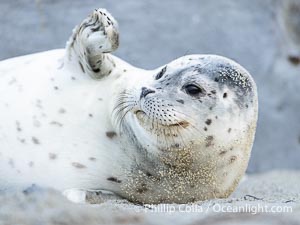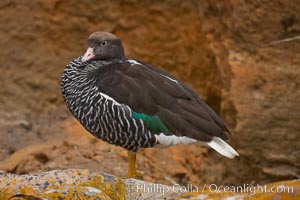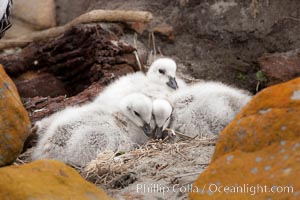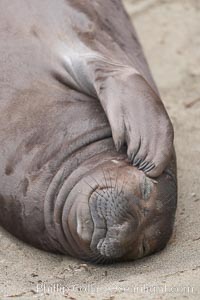
Gray whale raising its fluke (tail) in front of a boat of whale watchers before diving to the ocean floor to forage for crustaceans, Cow Bay, Flores Island, near Tofino, Clayoquot Sound, west coast of Vancouver Island.
Species: Gray whale, Eschrichtius robustus
Location: Cow Bay, Flores Island, British Columbia, Canada
Image ID: 21184
Species: Gray whale, Eschrichtius robustus
Location: Cow Bay, Flores Island, British Columbia, Canada
Image ID: 21184

Adelie penguins navigate a steep dropoff, to get from their nests down to a rocky beach, in order to go to sea to forage for food.
Species: Adelie penguin, Pygoscelis adeliae
Location: Paulet Island, Antarctic Peninsula, Antarctica
Image ID: 25020
Species: Adelie penguin, Pygoscelis adeliae
Location: Paulet Island, Antarctic Peninsula, Antarctica
Image ID: 25020

Visitors watch gentoo and Magellanic penguins on beautiful Leopard Beach, coming ashore after they have foraged at sea.
Species: Magellanic penguin, Spheniscus magellanicus
Location: Carcass Island, Falkland Islands, United Kingdom
Image ID: 23973
Species: Magellanic penguin, Spheniscus magellanicus
Location: Carcass Island, Falkland Islands, United Kingdom
Image ID: 23973

A sea otter, looking at the photographer as it forages for food in Elkhorn Slough.
Species: Sea otter, Enhydra lutris
Location: Elkhorn Slough National Estuarine Research Reserve, Moss Landing, California
Image ID: 21611
Species: Sea otter, Enhydra lutris
Location: Elkhorn Slough National Estuarine Research Reserve, Moss Landing, California
Image ID: 21611

Pacific Harbor Seal Pup in La Jolla About One Week Old. This young seal will be weaned off its mothers milk and care when it is about four to six weeks old, and before that time it must learn how to forage for food on its own, a very difficult time for a young seal.
Species: Pacific harbor seal, Phoca vitulina richardsi
Location: La Jolla, California
Image ID: 41003
Species: Pacific harbor seal, Phoca vitulina richardsi
Location: La Jolla, California
Image ID: 41003

Pacific Harbor Seal Pup in La Jolla About One Week Old With Its Mother. This young seal will be weaned off its mothers milk and care when it is about four to six weeks old, and before that time it must learn how to forage for food on its own, a very difficult time for a young seal.
Species: Pacific harbor seal, Phoca vitulina richardsi
Location: La Jolla, California
Image ID: 41004
Species: Pacific harbor seal, Phoca vitulina richardsi
Location: La Jolla, California
Image ID: 41004

Pacific Harbor Seal Pup in La Jolla About One Week Old. This young seal will be weaned off its mothers milk and care when it is about four to six weeks old, and before that time it must learn how to forage for food on its own, a very difficult time for a young seal.
Species: Pacific harbor seal, Phoca vitulina richardsi
Location: La Jolla, California
Image ID: 41005
Species: Pacific harbor seal, Phoca vitulina richardsi
Location: La Jolla, California
Image ID: 41005

Pacific Harbor Seal Pup in La Jolla About One Week Old With Its Mother. This young seal will be weaned off its mothers milk and care when it is about four to six weeks old, and before that time it must learn how to forage for food on its own, a very difficult time for a young seal.
Species: Pacific harbor seal, Phoca vitulina richardsi
Location: La Jolla, California
Image ID: 41006
Species: Pacific harbor seal, Phoca vitulina richardsi
Location: La Jolla, California
Image ID: 41006

Pacific Harbor Seal Pup About One Week Old Nursing. This young seal will be weaned off its mothers milk and care when it is about four to six weeks old, and before that time it must learn how to forage for food on its own, a very difficult time for a young seal.
Species: Pacific harbor seal, Phoca vitulina richardsi
Location: La Jolla, California
Image ID: 41010
Species: Pacific harbor seal, Phoca vitulina richardsi
Location: La Jolla, California
Image ID: 41010

Pacific Harbor Seal Pup in La Jolla About One Week Old With Its Mother. This young seal will be weaned off its mothers milk and care when it is about four to six weeks old, and before that time it must learn how to forage for food on its own, a very difficult time for a young seal.
Species: Pacific harbor seal, Phoca vitulina richardsi
Location: La Jolla, California
Image ID: 41014
Species: Pacific harbor seal, Phoca vitulina richardsi
Location: La Jolla, California
Image ID: 41014

Pacific Harbor Seal Pup in La Jolla About One Week Old With Its Mother. This young seal will be weaned off its mothers milk and care when it is about four to six weeks old, and before that time it must learn how to forage for food on its own, a very difficult time for a young seal.
Species: Pacific harbor seal, Phoca vitulina richardsi
Location: La Jolla, California
Image ID: 41017
Species: Pacific harbor seal, Phoca vitulina richardsi
Location: La Jolla, California
Image ID: 41017

Pacific Harbor Seal Pup in La Jolla About One Week Old. This young seal will be weaned off its mothers milk and care when it is about four to six weeks old, and before that time it must learn how to forage for food on its own, a very difficult time for a young seal.
Species: Pacific harbor seal, Phoca vitulina richardsi
Location: La Jolla, California
Image ID: 41019
Species: Pacific harbor seal, Phoca vitulina richardsi
Location: La Jolla, California
Image ID: 41019

Pacific Harbor Seal Pup in La Jolla About One Week Old. This young seal will be weaned off its mothers milk and care when it is about four to six weeks old, and before that time it must learn how to forage for food on its own, a very difficult time for a young seal.
Species: Pacific harbor seal, Phoca vitulina richardsi
Location: La Jolla, California
Image ID: 41020
Species: Pacific harbor seal, Phoca vitulina richardsi
Location: La Jolla, California
Image ID: 41020

Young Pacific harbor seal pup, only a few days old. This pup will remain with its mother for only about six weeks, at which time it will be weaned and must forage for its own food.
Species: Pacific Harbor Seal, Phoca vitulina richardsi
Location: La Jolla, California
Image ID: 40206
Species: Pacific Harbor Seal, Phoca vitulina richardsi
Location: La Jolla, California
Image ID: 40206

Young Pacific harbor seal pup, only a few days old, in surf at the edge of the ocean. This pup will remain with its mother for only about six weeks, at which time it will be weaned and must forage for its own food.
Species: Pacific Harbor Seal, Phoca vitulina richardsi
Location: La Jolla, California
Image ID: 40225
Species: Pacific Harbor Seal, Phoca vitulina richardsi
Location: La Jolla, California
Image ID: 40225

Young Pacific harbor seal pup, only a few days old. This pup will remain with its mother for only about six weeks, at which time it will be weaned and must forage for its own food.
Species: Pacific Harbor Seal, Phoca vitulina richardsi
Location: La Jolla, California
Image ID: 40228
Species: Pacific Harbor Seal, Phoca vitulina richardsi
Location: La Jolla, California
Image ID: 40228

Young Pacific harbor seal pup, only a few days old. This pup will remain with its mother for only about six weeks, at which time it will be weaned and must forage for its own food.
Species: Pacific Harbor Seal, Phoca vitulina richardsi
Location: La Jolla, California
Image ID: 40229
Species: Pacific Harbor Seal, Phoca vitulina richardsi
Location: La Jolla, California
Image ID: 40229

Kelp goose chicks eating kelp (seaweed). The kelp goose is noted for eating only seaweed, primarily of the genus ulva. It inhabits rocky coastline habitats where it forages for kelp.
Species: Kelp goose, Chloephaga hybrida, Chloephaga hybrida malvinarum
Location: New Island, Falkland Islands, United Kingdom
Image ID: 23754
Species: Kelp goose, Chloephaga hybrida, Chloephaga hybrida malvinarum
Location: New Island, Falkland Islands, United Kingdom
Image ID: 23754

Kelp goose, male showing entirely white plumage. The kelp goose is noted for eating only seaweed, primarily of the genus ulva. It inhabits rocky coastline habitats where it forages for kelp.
Species: Kelp goose, Chloephaga hybrida, Chloephaga hybrida malvinarum
Location: New Island, Falkland Islands, United Kingdom
Image ID: 23755
Species: Kelp goose, Chloephaga hybrida, Chloephaga hybrida malvinarum
Location: New Island, Falkland Islands, United Kingdom
Image ID: 23755

Kelp goose, female with multicolored plumage very different from the pure white of male kelp geese. The kelp goose is noted for eating only seaweed, primarily of the genus ulva. It inhabits rocky coastline habitats where it forages for kelp.
Species: Chloephaga hybrida, Chloephaga hybrida malvinarum
Location: New Island, Falkland Islands, United Kingdom
Image ID: 23758
Species: Chloephaga hybrida, Chloephaga hybrida malvinarum
Location: New Island, Falkland Islands, United Kingdom
Image ID: 23758

Kelp goose chicks, nestled on sand between rocks. The kelp goose is noted for eating only seaweed, primarily of the genus ulva. It inhabits rocky coastline habitats where it forages for kelp.
Species: Kelp goose, Chloephaga hybrida, Chloephaga hybrida malvinarum
Location: New Island, Falkland Islands, United Kingdom
Image ID: 23759
Species: Kelp goose, Chloephaga hybrida, Chloephaga hybrida malvinarum
Location: New Island, Falkland Islands, United Kingdom
Image ID: 23759

Patagonian crested duck, on sand beach. The crested dusk inhabits coastal regions where it forages for invertebrates and marine algae. The male and female are similar in appearance.
Species: Crested duck, Lophonetta specularioides
Location: New Island, Falkland Islands, United Kingdom
Image ID: 23764
Species: Crested duck, Lophonetta specularioides
Location: New Island, Falkland Islands, United Kingdom
Image ID: 23764

Water falling from the fluke (tail) of a humpback whale as the whale dives to forage for food in the Santa Barbara Channel.
Species: Humpback whale, Megaptera novaeangliae
Location: Santa Rosa Island, California
Image ID: 27035
Species: Humpback whale, Megaptera novaeangliae
Location: Santa Rosa Island, California
Image ID: 27035

Elephant seal pup scratches its face with its foreflipper. Note the five "fingernails" on the flipper. The pup will nurse for 27 days, when the mother stops lactating and returns to the sea. The pup will stay on the beach 12 more weeks until it becomes hungry and begins to forage for food.
Species: Elephant seal, Mirounga angustirostris
Location: Piedras Blancas, San Simeon, California
Image ID: 20404
Species: Elephant seal, Mirounga angustirostris
Location: Piedras Blancas, San Simeon, California
Image ID: 20404

Adelie penguins navigate a steep dropoff, to get from their nests down to a rocky beach, in order to go to sea to forage for food.
Species: Adelie penguin, Pygoscelis adeliae
Location: Paulet Island, Antarctic Peninsula, Antarctica
Image ID: 25070
Species: Adelie penguin, Pygoscelis adeliae
Location: Paulet Island, Antarctic Peninsula, Antarctica
Image ID: 25070

Adelie penguins walk along the edge of the sea, before leaving en masse to forage for food.
Species: Adelie penguin, Pygoscelis adeliae
Location: Paulet Island, Antarctic Peninsula, Antarctica
Image ID: 25067
Species: Adelie penguin, Pygoscelis adeliae
Location: Paulet Island, Antarctic Peninsula, Antarctica
Image ID: 25067

Water falling from a blue whale fluke as the whale dives to forage for food in the Santa Barbara Channel.
Species: Blue whale, Balaenoptera musculus
Location: Santa Rosa Island, California
Image ID: 27022
Species: Blue whale, Balaenoptera musculus
Location: Santa Rosa Island, California
Image ID: 27022

Water falling from a blue whale fluke as the whale dives to forage for food in the Santa Barbara Channel.
Species: Blue whale, Balaenoptera musculus
Location: Santa Rosa Island, California
Image ID: 27024
Species: Blue whale, Balaenoptera musculus
Location: Santa Rosa Island, California
Image ID: 27024

Water falling from the fluke (tail) of a humpback whale as the whale dives to forage for food in the Santa Barbara Channel.
Species: Humpback whale, Megaptera novaeangliae
Location: Santa Rosa Island, California
Image ID: 27028
Species: Humpback whale, Megaptera novaeangliae
Location: Santa Rosa Island, California
Image ID: 27028

Water falling from the fluke (tail) of a humpback whale as the whale dives to forage for food in the Santa Barbara Channel.
Species: Humpback whale, Megaptera novaeangliae
Location: Santa Rosa Island, California
Image ID: 27030
Species: Humpback whale, Megaptera novaeangliae
Location: Santa Rosa Island, California
Image ID: 27030